Brain Food's top tips for making jams, pickles, chutney and relish
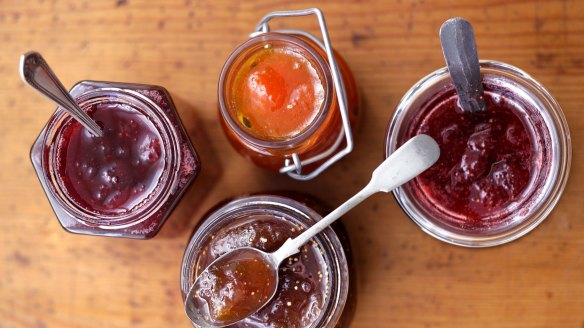
Has preserving got you in a pickle? Here are Brain Food columnist Richard Cornish's answers to all your preserving questions, to help get you out of a jam.
Jam and marmalade
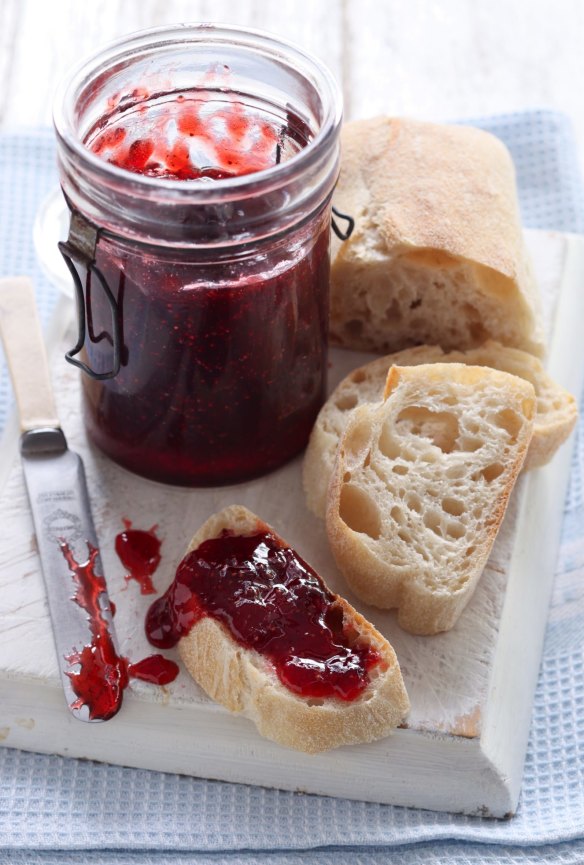
How do I stop my jam from crystallising? I. Zeitman
When I first arrived in London as a backpacker in the 1990s I remember being amazed at the way Australians were attracted to each other, forming raucous braying mobs in pubs and clubs. Sugar molecules, even when dissolved in liquid as they are in jams, like to form into groups - or crystals. They love a party starter and will consolidate around a nucleus, which could be an air bubble, a fleck of dust or – most likely – another sugar crystal.
When making jam, avoid creating crystals by cooking over gentle heat therefore making the sides of the pot – on which crystals may form – too hot. Do not stir the jam as it cools before you put it into the jars. Make sure the jars are spotlessly clean. If a jam does crystallise, reheat it, add a little lemon juice to inhibit crystallisation and pour into a clean jar.
I have so much stone fruit – how do I preserve it? L. Handley
When I was growing up on the farm, my family inherited an orchard of gnarled fruit trees. Their limbs were cloaked in layers of lichen and riddled with various forms of canker. They had grown protected from the prevailing winds by a hedgerow of cypress. Every odd year they threw a surfeit of fruit. This was in the era before freezers, so some of the softer fruit were turned into jams. We cooked apricots with an equal weight of sugar plus the fleshy kernel of the apricot pip to add a marzipan note to the conserve, plus half lemons to add acid and pectin.
Apricots love a touch of warm spice such as cinnamon or cardamom and even a pinch of salt. Blemished nectarines received a similar treatment. But as you know, there is not much better than a tree-ripened nectarine. What we didn't eat direct from the boughs became valuable barter for the neighbour's late-spring lamb chops. That was when I discovered just how well grilled lamb and grilled nectarine go together.
The clingstone peaches were blanched in hot water, stones removed, and drowned in light sugar syrup made by dissolving 200g of sugar in one litre of water over heat. The peaches' skin was slipped off and the flesh sliced into lobes, which were then dropped into sterilised Fowlers Vacola jars, covered with the light syrup, sealed, and put into the old green steel pasteuriser for an hour. The bottled peaches would appear a few weeks later as the bottom layer of the Christmas trifle.
Technology has given us some great dehydrators that make excellent dried fruit and leathers. If freezing apricots and peaches, blanch to remove the skin first as skin can harden during freezing. Cut apricots in half and larger fruit into lobes. Place flat in small containers and cover in light syrup or water. Cover and freeze for up to six months.
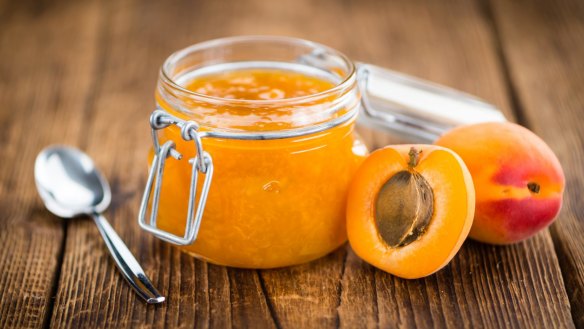
I am making apricot jam and wanted to add some of the apricot kernels but I heard that they contain small amounts of cyanide. How many kernels are safe? D. R. Song
Have you been binge-watching Midsomer Murders and are now thinking of bumping someone off in a convoluted plot full of twists and very uptight white people? Yes, apricot kernels do contain a compound called amygdalin, which is a cyanogenic glycoside. When it hits the acids in the stomach it releases hydrogen cyanide, causing discomfort or illness. It can be fatal.
The Australian Food Safety Information Council recommends you consume no more than three kernels a day for adults and none for children. Different types of apricot kernels have different levels of amygdalin so if you're in doubt, leave them out.
How does sugar preserve jam? P. Goss
I remember visiting family friends in far-north Queensland years ago, in the days before a television tower was built in their town. The kids would amuse themselves at night by pouring salt on the backs of cane toads.
The toads' cells would automatically release water to try to even out the salt/water balance. This is called osmosis. There was so much salt on the toads, they would dehydrate and die. Salt and sugar have the same effect on harmful bacteria.
A very, very sweet food, such as jam or marmalade, has so much sugar dissolved in the liquid, if a bacterium comes into contact with it, the sheer concentration of sugar will draw away moisture and disable it.
Anyone who has lifted a wax seal on jam to discover a layer of green scum, however, will understand that moulds can still grow on jam, which is why sterilising jars and lids is important. Some jam-makers put their sealed jars in water at about 80 degrees Celsius for 20 minutes to pasteurise them.
Can I use stevia to make jam? J. Edwards
Let's change the word "'jam" to "conserve" or "preserve", as in "strawberry preserve". Because that is what you are doing when you make jam. You are preserving the fruit by adding sugar to it and cooking it together. Foods that are really sweet don't spoil quickly. Make chocolate syrup and it won't go off in a hurry. Sugar draws liquid from cells. Notice how undiluted honey doesn't ferment? That's the sugars in honey killing off the wild yeast that could ferment it. You've heard of sugar-cured salmon? When you start cooking preserves, the normal sugar-to-fruit ratio is about 50:50. The sugar pulls water out of the fruit and the water partially evaporates during cooking, so you end up with about 65 per cent sugar. If unwanted microbes get into the preserve the sugar pulls water out of them as well. The sugar also helps the pectin from the fruit form a gel – which is why jams go thick or have a jelly. Stevia is not sugar or a type of sugar. It is a plant that has a compound that activates the taste buds, creating a sensation of sweetness.
Stevia extract has 200 times the sweetening ability of sugar but has almost no carbohydrate. It also doesn't help pectin gel. There are recipes for fruit coulis that are sweetened with stevia but these last about a week and need to be refrigerated. If you have health problems you might want to do some more reading on the negative health effects of long-term consumption of stevia and other artificial sweeteners.
Why can't one buy preserving wax any more? I went to four supermarkets and there was none to be found. M. De Saint-Ferjeux
How times change. A generation ago there were different brands of preserving wax competing for shelf space. Now there are numerous brands of depilatory wax. Preserving wax, for the younger readers, is made from paraffin and is poured over freshly made jam to create a seal to stop the formation of mould.
Try the local family-owned hardware store (Bunnings doesn't stock it) or order good old Fowlers Vacola online.
You also can pasteurise freshly made jam poured into screw-seal jars by carefully simmering them in a large saucepan for an hour or so. Place jars on a immersed round cake rack so the jar bottoms don't touch the bottom of the saucepan. Drain, protect hands with a dishcloth, tighten lids, allow to cool, store in a cool dark place.
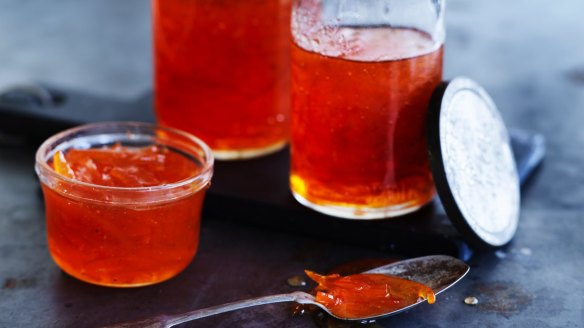
Is there an appliance or gadget that will thinly cut my citrus fruits for marmalade? J. Drysdale
Every year in March I help MC the Red Hill Show, a little country show with a big heart. I have the enviable task of working with the Country Women's Association. It's a political lobby group pushing for better health, social and community services in regional areas under the cloak of scones, sponges, fruit cake and jam. "Good food brings people together at the table," former president Noela Macleod says. "There the important discussions can be had."
The disdain some of those women hold for those who use a food processor to chop citrus fruit for marmalade is palpable. Their preferred marmalade is "fine cut". This means fine strips of orange, preferably Seville orange, trimmed of pith, suspended in a bright amber-coloured jelly. Fine-cut marmalade is a work of art and takes time.
I have tried a sharp mandolin in the past, but the skin of the oranges tends to tear. I have also tried the slicing blade (not the chopping blade) of the food processor. The result is adequate, but it is hard to get evenly sized slices. I still find the best device is a freshly sharpened knife given a good touch-up with the steel between oranges.
I made lime marmalade with yellow limes successfully but when I tried it with green limes the result was less than successful, with very tough skin. R. Henley
It has been a sensational year for Tahitian limes and from the rest of your letter it seems you have received, literally, a windfall from a neighbour. The dark green ones are simply unripe Tahitian limes. The yellow ones are ripe.
When ripe, citrus skin is about 30 per cent pectin; this is a type of starch that forms a gel when cooked with sugar and acid. The rest is much tougher cellulose and hemicellulose. When limes are unripe there are proportionally a lot more of these compounds that don't break down when cooked.
As an aside, it's interesting to note that when fruit such as berries refuses to set we add a squeeze of lemon juice. This lowers the pH and helps the pectin bond to create a gel. The addition of actual lemon peel, with all its white pith, increases the overall level of pectin.
I grow lemonades, which are a delicious fruit, and not as bitter as some varieties of citrus. Would they be suitable for marmalade? And given they are much less tart, would I need to use less sugar? G. Costa
Lemonade lemons (Citrus limon x reticulata) are a cross between a lemon and a mandarin and are, as you write, not as sharp as a lemon.
Marmalade is a form of preservation. If you add enough sugar to fruit and cook it, the osmotic pressure from the sugar draws water from yeast and bacteria, killing them or rendering them inactive. Also fruit preserves such as marmalade and jam need pectin to set. This is the starch in the cell walls that is extracted by cooking in water or the water in the juice of the fruit.
The pectin won't bond and set into a gel if there is too much water. What the sugar does is absorb a lot of the water, allowing the pectin to jelly-up, as it were. So the sugar in marmalade is not about sweetness; it's about preserving the fruit and making the pectin gel.
Follow an orange marmalade recipe and see how it goes. Perhaps if the marmalade is too tart you might want to shandy the recipe with a few oranges.
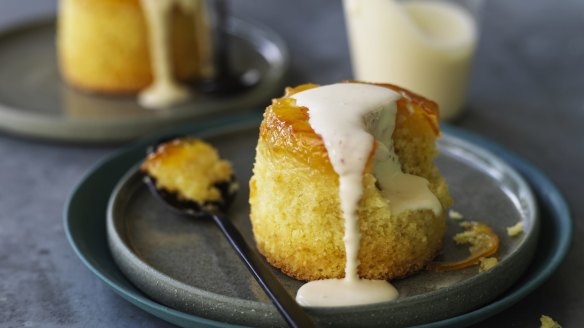
What can I do with jars of old marmalade? C. O'Neill
There is a great chef called Suzi McKay, who used to grow all her vegetables for her restaurant long before it was fashionable. She smoked her lamb racks in the flue of a wood stove and had a collection of aged hand-made preserves. I tracked her down to her restaurant, the Five Fires, at the Jordan in Port Lincoln. Although I have not found any health authority information to back her statement, she claims: "Properly made marmalade never goes off. It ages like wine."
She reeled off a series of ideas on how to use aged marmalade: try it in a bread-and-butter pudding made with croissants; or a steamed pudding with marmalade at the bottom of the bowl; or a dipping sauce or marinade for steamed snapper with ginger, chilli, fish sauce, soy sauce and marmalade.
"When I had the Harvest Home Hotel," she said, "I would sear a duck's breast, slather it in aged marmalade, then throw it into a stinking-hot oven and serve it with a baked eggplant seasoned with Moroccan spices."
Where does marmalade originally come from? D. Bishop
Quinces. The Greeks and Romans made a paste from quinces, lemons and honey. The Greeks called it melimelon, a combination of the words for honey and apple. Quinces are packed with pectin and form a sweet jelly when cooked. The Spanish for quince paste, membrillo, comes from the Greek original, as does the Portuguese marmelada.
In English, a marmalet long referred to preserves made with quince, pear, apple and crab apple. There are mentions of an orange marmalet in the 1700s, with Boswell and Johnson breakfasting on the spread in Scotland in the 1770s. It was commercialised in Dundee in the mid-1800s using bitter Seville oranges as the base fruit.
Chutney and relish
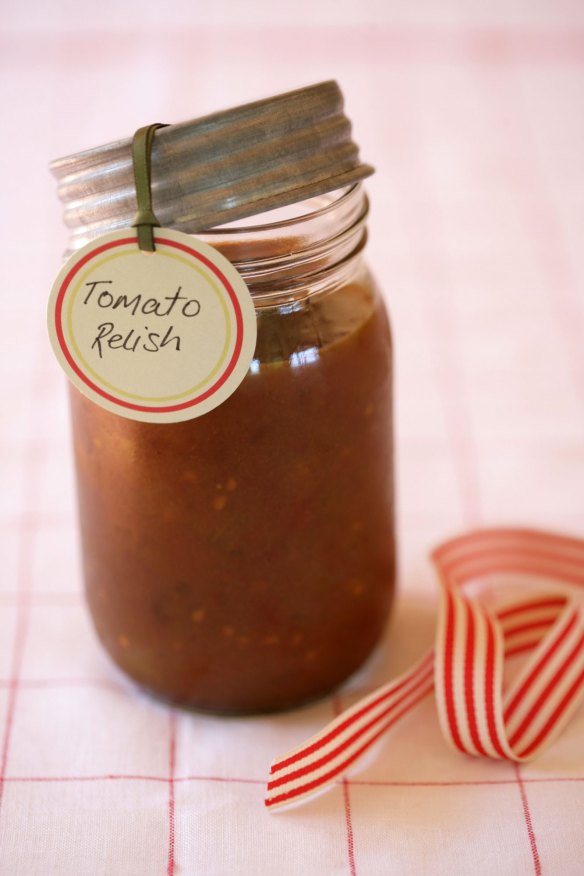
What is the difference between relish and chutney? L. Barnes
There is a product from England called the Gentleman's Relish that has been made to the same recipe since 1828. It is a mix of anchovies, butter, herbs and spices. Then a relish was "a highly flavoured item of food taken with plainer food to add flavour or interest to it", according to The Oxford Companion to Food. Relish could therefore be something like pickled onions served on a ploughman's platter or pickled cucumbers with a cheese board.
The word "relish" in Australia has changed meaning through usage and now refers to preserved fruit and vegetables prepared as a savoury condiment. Go to any church fair in a country town and you'll find anything from the local gardens cooked with sugar, vinegar and spices and turned into a "relish". Tomato relish. Gooseberry relish. Bloody feijoa relish.
Etymologically speaking, relish comes from the same Old French as relais or "the remainder", the old idea that "taste" was the remainder after eating. Chutney comes from the Hindi word chatni and in India refers to a side dish of spicy condiment of perhaps ground mint, ginger, garlic, tamarind, lime and coconut. So traditionally Indian chutney is a subset of relish. The British chutneys to which we have become accustomed are generally sweet and cooked and preserves yet containing vestiges of spiciness. This is perhaps now the only difference between chutney and relish in the modern Australian culinary landscape.
What do I do with Gentleman's Relish? S. Davern
Also know as Partum Peperium, this deliciously salty blend of anchovies, butter and herbs was first made in 1828 and is still produced today by Elsenham Quality Foods in Elsenham, England. Spread it sparingly on thinly sliced dry toast and perhaps top with a fine slice of cool cucumber or something sharp such as mustard cress, watercress or a scant smear of freshly grated wasabi.
It is particularly high in umami, so consider adding a little to a meaty gravy, a white sauce to pour over cauliflower cheese, blended through some creme fraiche with a little chervil spread on a cracker as a simple canape, or make a paste in a mortar and pestle with young rosemary leaves and insert into knife punctures in a shoulder of lamb before slow-roasting. It pretty well goes with every savoury food from England in the 19th century, in lesser or greater amounts according to taste.
What is the best method for sterilising bottles and jars for passata and chutney? L. Parker
I went to one of those schools where the boys were made to dress in ill-fitting army greens and march around the quadrangle while the one of the teachers barked orders in a fashion he may have learned from watching too many WWII movies. We were sent on camps where older boys would again bark orders at us. Funnily enough, I was relegated to the position of cook. It was my job to prepare meals and clean pots. I remember our cadet under officer screaming at me to make sure there was not a skerrick of food left on the pots as this is where the bugs grow.
A batch of passata or chutney can be ruined by unhygienic jars. They must be immaculately clean before they are sterilised. To sterilise jars, simmer in boiling water for 30 minutes. Make sure lids and seals are also sterilised. Or place jars in a cool oven and heat to 120 degrees for 10 to 15 minutes. Pour hot conserves into hot jars and seal immediately to create that "vacuum" seal.
I am making mostarda (mustard fruit) and can't find Italian mustard essence. N. Maloney
Try mustard oil instead, from Indian and Pakistani grocers. The concentration of the acrid compound derived from the mustard seeds can differ from brand to brand so add to taste. Be careful handling mustard oil as its concentrated heat can burn skin and eyes.
Pickling
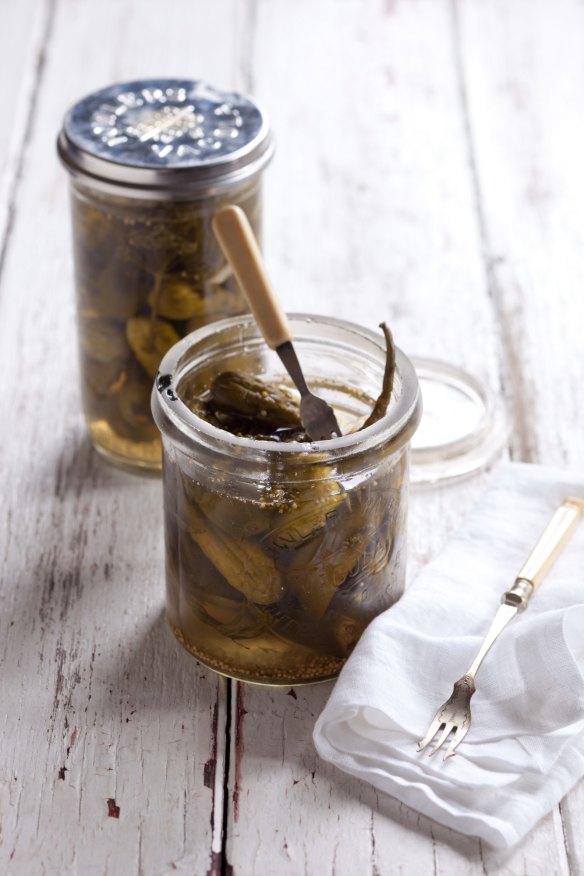
Can I use the vinegar from my pickled cucumbers for another batch? R. O'Shea
One of summer's great joys is picking the first zucchinis of the season from the garden and pulling out Stephanie Alexander's Cook's Companion and flicking through to find her turmeric-rich recipe for pickled zucchini. I have had one jar in the cupboard for several years. That a jar of food can last so long without going off is due to the acid in the vinegar.
Bacteria, such as those that cause botulism poisoning, cannot survive when the pH drops below 4.5. The lower the pH, the more acidic the sample you're testing. Water has a pH of 7, black coffee 5 and tomato juice 3.5. But you also want to stop the pickles from fermenting. Natural fermentation from the lactobacillus present on plants turn sugars into lactic acid. They keep producing lactic acid (making the environment inhospitable to bad bugs) until the pH drops to about 4 or 3.5. So you need quite an acidic solution to stop the pickles fermenting. This is why you use vinegar, which has a pH of about 2.5-2.
However, as the cucumbers sit in the vinegar solution, they release water, diluting the vinegar and raising its pH. So it is not a good idea to re-use the vinegar as you may bring about fermentation in the ensuing batch. Once you've eaten all the pickles, you could use the remaining vinegar to start a mayonnaise, flavour a potato salad or liven up a dip.
Another idea would be to use salt and naturally occurring lactobacillus to make really tasty pickles with a lovely lactic tang and a softer, smoother finish than vinegar pickles. See Sharon Flynn's recipe for dill pickles from her book Ferment for Good.
Why do cooks put dill in pickled cucumbers? S. Morley
Dill seeds contain compounds that can retard microbial growth. There is a myth that in days gone by, cooks would put spices on food to mask that it had gone off. Spices today are still relatively expensive but in the days before mass transport they were literally worth their weight in gold. I contend that spices were, instead, used to help preserve food.
The compound thymol in thyme and oregano helps increase microbiological stability in food, as does eugenol, found in allspice, cloves and cinnamon. Cinnamon itself is a source of cinnamic aldehyde, as is its cousin cassia. The fact we find plants that help preserve food desirable speaks volumes about the way our appreciation of different flavours has evolved and changed over millennia.
Do you have a simple method for preserving olives? Dr. R. Sony
For the life of me I can't remember who taught me this. I think the exchange of information was done over some grappa. It is a slow process that involves patience, lactic fermentation and possibly neglect.
I take the olives when they are ripe, wash them then place them in one of those 10-litre buckets you can buy at hot bread bakeries. The bucket must be clean. I top up with fresh water and whack an old, heavy plate on top to weigh the olives down. Some people swear it is essential to slit the skin but I wait until the olives are ripe enough for the birds to find them palatable. I leave the buckets in the shade outside and for two weeks I replace the water every day.
When they're no longer bitter I drain the olives and place them in washed and sterilised two-litre glass jars and cover with brine made with 100 grams of salt to every litre of water. I pour the brine over the olives, covering them completely, seal them with a lid and leave them for six months to ferment. I use them straight from the jar or remove and serve them warmed with a little extra virgin olive oil and herbs from the garden.
Reader B. Mitchell offers another way of preserving them. "I am an Australian who has lived on the Mediterranean for 10 years. I have 12 200-year-old olive trees. I have tried every method going back to Roman times to cure them. These methods are time-consuming and can fail if you make one miscalculation.
"Here is a failsafe, easy way to get olives to a state where they can be enjoyed with wine and in food. Place ripe olives on a baking dish lined with foil. Sprinkle with olive oil and plenty of sea salt. Place in a preheated oven at 180C for 25 minutes. Allow to cool. Store in the refrigerator."
I preserved some olives and they started bubbling. V. Raffa
I spoke to my mate Neil Seymour from Mount Zero Olives. He and his wife Jane have a vast grove of old trees in the foothills of the Grampians National Park (Gariwerd) in Western Victoria. There they make some of the best preserved olives in the country. I told him of your problem and he said it was most likely the wrong sort of bacteria.
When you place olives in a salt solution, this draws juice from the cells and in the ideal situation lactic acid bacteria turn sugars in the juice into lactic acid. This acid stops other bacteria, moulds and yeasts from spoiling the olives. Sometimes other bacteria get into the olives and start fermentation that produces gas, hence the fizzing and bubbles.
Neil suggested that perhaps you didn't have enough salt in the brine and that by adding more it would stop the bad bacteria and let the lactic acid bacteria take over and do their job.
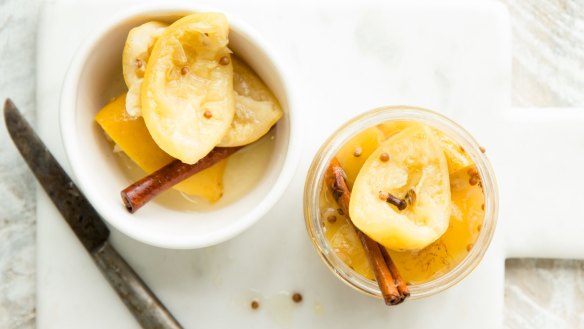
What is the jelly at the bottom of preserved limes and lemons? G. Parry
Preserved lemons received as a gift can sit for years in their jar in the fridge in an emotional no man's land. Too precious to throw away, too exotic to use every day, the citrus silently transforms in the jar, the starch in the cell walls – pectose – slowly converting to pectin. Pectin, as you know, sets jelly. Liquid exuding from the fruit settles at the bottom of the jar and the pectin turns it into a jelly.
There is a sensational recipe for preserved lemon in Stephanie Alexander's Moroccan-inspired chicken in her Cook's Companion – a delicious dish of chickpeas, pumpkin, chicken, coriander, cumin and preserved lemon.
Send your vexing culinary conundrums to brainfood@richardcornish.com.au or tweet to @foodcornish
The best recipes from Australia's leading chefs straight to your inbox.
Sign up- More:
- How to
- Brain food
